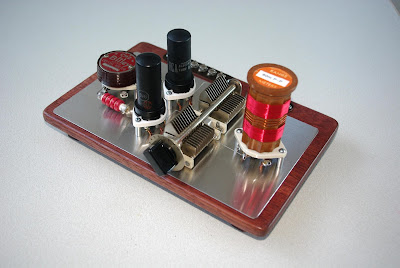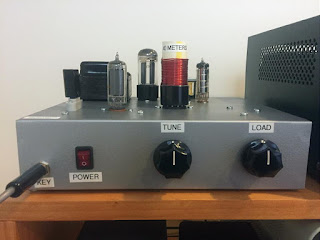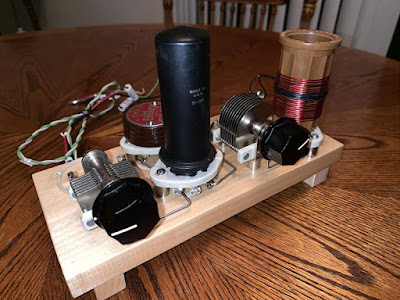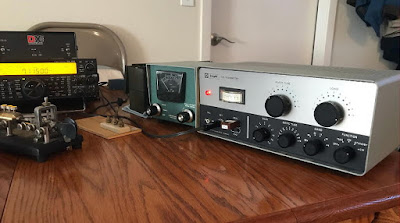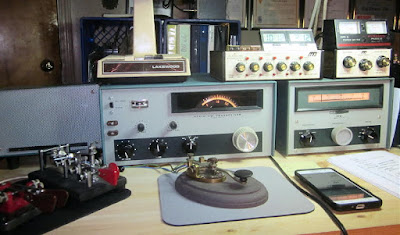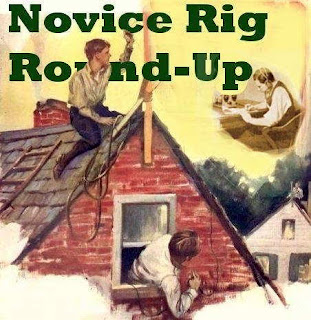Author Archive
 Hunting For NDBs In CLE242
Hunting For NDBs In CLE242
 |
| Online KiwiSDR Network |
CLE242 runs this weekend and is a bit different than most. This time, listeners are required to use an online remote receiver to do their beacon-hunting.
There are many parts of the world where beacons have yet to be recorded to the database and this will be a great opportunity to find and report them.
Over the past few years, the number of online SDRs has grown immensely, as has their ease of use. Although there are several online systems, my favorite is the KiwiSDR network, where one can normally find over 400 receivers available at any time. As well, every one of them has the same familiar intuitive interface ... figuring out how to tune them and make them behave the way you want only takes a few moments.
When tuning for NDBs, put your receiver in the CW mode and listen for the NDB's CW identifier, repeated every few seconds. Listen for U.S. NDB identifiers approximately 1 kHz higher or lower than the published transmitted frequency since these beacons are modulated with a 1020Hz tone approximately.
For example, 'AA' near Fargo, ND, transmits on 365 kHz and its upper sideband CW identifier is tuned at 366.025 kHz while its lower sideband CW ident can be tuned at 363.946 kHz. Its USB tone is actually 1025 Hz while its LSB tone is 1054 Hz.
Often, one sideband will be much stronger than the other so if you don't hear the first one, try listening on the other sideband.
Canadian NDBs normally have an USB tone only, usually very close to 400 Hz. They also have a long dash (keydown) following the CW identifier.
All NDBs heard in North America will be listed in the RNA database (updated daily) while those heard in Europe may be found in the REU database. Beacons heard outside of these regions will be found in the RWW database.
From CLE organizer Brian Keyte, G3SIA, come details via the The NDB List Group:
Hello all
Our 242nd listening event starts this Friday. The last time everyone
listened via remote receivers was 40 CLEs and over 3 years ago. Since
then the receivers have improved enormously – easier to use, better
design and a much greater choice of sites Worldwide for you to use.
If you don’t like the idea of remote listening we urge you to at least
please give it a try. I predict that several of us who ‘have a go’ in this
CLE will be very pleased to discover a fascinating new world of NDBs.
You only need a modest PC and a slow internet connection - and the
ability to read slow Morse! (Even a tablet is sufficient, though a bit
difficult to use without a mouse)
Days: Friday 22 March - Monday 25 March
Times: Midday on Friday to Midday on Monday, local time AT THE REMOTE RX
QRG: Normal LF/MF frequencies (190 - 1740 kHz)
NDBs: A MAXIMUM of 100 normal NDBs (not DGPS, Navtex, Amateur)
(that’s not intended to be a target to reach!)
Choose any ONE receiver, remote from you, for all your CLE listening.
Remember that reception conditions will depend on the local time of
day/night at the receiver (no through-the-night listening for us this time?)
The ‘biggest and best’ of the remote receivers is probably still the SDR
at the University of Twente at Enschede in the east of Holland.
Several hundred listeners use it, all at the same time and all unaware
of each other. Its PA0RDT mini-whip aerial high above the metal roof
of the building allows it to receive well on the NDB range of frequencies.
Just enter http://websdr.ewi.utwente.nl:8901/ into your browser.
In seconds you should see details of the receiver and advice on how to
use it.
If you want to choose a different location, or an easier-to-use receiver
with fewer facilities, the Kiwi receivers are also SDRs. They are mostly
in radio enthusiasts homes and they usually only support a handful of
simultaneous users.
Go to https://sdr.hu
To display the Worldwide map use the button on the right side of the screen
- experiment with (multiple) use of the + and – buttons.
Some sites of any kind have aerials that are quite unsuitable for NDB
listening, but others are excellent. Some of our members have been busy
recently researching them and their suggested ‘best ones’ are listed below.
For each receiver, whatever its kind, do read the helpful advice carefully
before using it. There is no charge and you don’t register or 'log in', but
you may be invited to type your chosen identification in a 'Name’ or
‘Callsign' box. There may be a time limit for each user (e.g. 2 hours in
any 24 hours) and ‘late comers’ may temporarily have reduced facilities.
Seeklists? The REU/RNA/RWW Website can help a lot if you enter the
Locator of your chosen receiver in the From GSQ box there.
To avoid getting details of thousands of NDBs, initially set the DX limit
to something small and/or enter one or two nearby states or countries.
LOGS (Please read CAREFULLY):
Please show the LOCATION details and the TYPE OF REMOTE RECEIVER
clearly (and your own location to help us identify you).
Include on EVERY LINE of your log:
# the UTC date - e.g. ‘2019-03-22' (or just '22')
and UTC time (the day changes at 00:00 UTC).
# kHz - the nominal, published, frequency.
# Call Ident.
Show those main log items FIRST. Any other, optional, details such as
the NDB's location, etc., must go LATER on the same line.
You could include any UNIDs - e.g. separately if you already have 100
identified loggings.
As this is a special CLE, any extra comments in your log on your listening
experience (whether good or not!) will certainly be of interest.
Please post your log to NDB List, preferably as a Plain Text email
(not in an attachment) using 'CLE242' and ‘FINAL’ in its title. We will
send the usual 'Any More Logs?' email at about 21:00 UTC on Tuesday
so you can check that your log has been found OK.
(NB: that is 3 hours later than usual)
Do make sure your log has arrived on the List by 09:00 UTC on Wednesday
27 March at the very latest. Joachim and I hope to finish making the main
combined results later on that day or soon after.
REMINDERS:
Only ONE remote receiver of your choice.
Not more than 100 loggings
Start and End at midday at the receiver.
Enjoy!
Brian
--------------------------------------------------------------------------
From: Brian Keyte G3SIA ndbcle'at'gmail.com
Location: Surrey, SE England (CLE Coordinator)
--------------------------------------------------------------------------
To help you with your choice of a remote receiver, below are recommendations
and/or advice provided by from some of our members:
they can still be used and are still excellent stations.
Advice about their own and other Kiwis have been given in emails to NDB List,
mostly in the last few days:
Roelof B: His KiwiSDR is making all four channels available for the CLE
Tony C: Has added his openwebrx NDB receiver to SDRHU. 3 or 4 users
Bill S: Email to NDB List on 4 Feb (A list of USA and CAN SDR's that may
be useful, compiled by Dave AB5S and posted on the Boatanchor List)
Joe N5PYK: The West Texas KiwiSDR welcomes CLE participants.
We are grateful to all the above.
Any further advice about suitable remotes will be welcome.
Do you fancy using something really basic for the CLE? The Global Tuners
still exist – we used 6 of them successfully in CLE202. There are usually
about 50 of them on-line and many are older traditional receivers that
support only one user and are seldom suitable for the NDB frequencies.
But there might still be a gem or two among them:
https://www.globaltuners.com/ (You need to sign up for a free account
and provide an email address for a password to be sent to you)
- determine, worldwide, which beacons are actually in service and on-the-air so the online database can be kept up-to-date
- determine, worldwide, which beacons are out-of-service or have gone silent since the last CLE covering this range
- will indicate the state of propagation conditions at the various participant locations
- will give you an indication of how well your LF/MF receiving system is working
- give participants a fun yet challenging activity to keep their listening skills honed
The NDB List Group is a great place to learn more about the 'Art of NDB DXing' or to meet other listeners in your region. There is a lot of good information available there and new members are always very welcome. As well, you can follow the results of other CLE participants from night to night as propagation is always an active topic of discussion.
You need not be an NDB List member to participate in the CLEs and all reports, no matter how small, are of much value to the organizers.
Remember - 'First-time' logs are always VERY welcome!
Reports may be sent to the NDB List Group or e-mailed to CLE co-ordinator, Brian Keyte (G3SIA), whose address appears above. If you are a member of the group, all final results will also be e-mailed and posted there.
Please ... give the CLE a try ... then let us know what NDB's can be heard from your location! Your report can then be added to the worldwide database to help keep it up-to-date.
Have fun and good hunting!
 My 2019 Novice Rig Roundup Summary
My 2019 Novice Rig Roundup Summary

Once again the Novice Rig Roundup (NRR) has come and gone ... and once again, it was the most enjoyable 'contest' of the year for me.
What I have come to enjoy most about the NRR is that most participants do not really treat it as a contest but more as an opportunity to spend some relaxing CW time enjoying some of their favorite vintage rigs ... spread out over nine days of activity. Since there was never a Novice-class program in Canada, I was never a Novice, but the NRR brings back all of the good memories experienced as a newly-licenced radio-crazed 15 year old operator!
Back in those times, there was a gratifying sense of achievement with every contact. My clap-trap collection of parts and tin gutter-pipe verticals, mounted atop our old four-story city house, magically sent my tiny signal from coast to coast and over the pole.

Those were the dying days of big-daddy Cycle 19, and my station was proof that just a tiny bit of RF was all that was needed under such amazing solar conditions.
This year's NRR began by making a couple of contacts with my Drake 2NT and VF-1 VFO but my newly-finished 1936-style Jones Push Pull Oscillator was begging to be put to the test. This meant that the remainder of the week would be spent using crystal-control and in all likelihood, sending a hundred or more 'CQ NRR's, hopefully attracting some of the crowd.
Due to previous commitments, I missed a few nights of operating but ended up with 53 NRR contacts in 23 different states or provinces. Operating on 40m in the late afternoon and then for a short period on 80m after dinner, proved to be the best use of my time, as usually, much of the eastern activity had closed shop for the night, just as the band was getting good. There were two nights of superb 80m propagation but with very little NRR activity ... unfortunately for many participants, late-night operating (even with wonderful propagation) is not in the cards for those that must rise early for work the next morning!
There were several highlights for me once again and being able to create them while using my new homebrew rig was very gratifying.
Roger, VA1RST, back in Halifax, Nova Scotia, was one east-coaster that seemingly cherished the midnight-oil! His great Drake 2B ears were able to copy the little 'Jones' on 80m with no problem and his participation added an exotic DX-flavor to the NRR.
Michael, W3TS, managed to squeeze enough RF from his one-tube 6AG7 crystal oscillator to be heard and worked here on both 40 and 80m, with a respectable 559 on 40 and 569 on 80!
It wasn't until after the NRR was over that I realized why Mike's call was familiar as we had worked a couple of times already this winter on the 630m band (475kHz) ...doh!
More transcon magic was made when Tom, K3AJ, finessed a few watts from his single 6CL6 crystal-controlled DX-machine to the west coast on both 80 and 40m. The propagation gods must have been paying close attention as his 40m signal was a solid 579 while his late-night 80m signal was a whopping 589 here ... 80m propagation just like the good old days!
Not to be outdone by Tom, ex-Nebraskan Andy, KØSM in New York, kept his vintage '42' clipped together long enough to be worked back here as well. With just a couple of watts from the early '30s tube, his signal was no problem on both bands.
Gary, W8PU, with his newly-built mid-30s 6L6 tri-tet oscillator, was another treat from the east when his 559 80m signal arrived here from Ohio in good form.
A little closer to home, WB2AWQ, Howie down in Reno, had a whopping signal all week whenever I heard him on 40m. Howie can always be counted upon for 'NV' in most vintage rig operating events, including the 1929 BK Party. This time 'round, he was using his BC-458A, crystal-controlled at 35 watts out. It's a good bet that hundreds of Novices got their start with a surplus Command set such as this, which often sold for just a few dollars in the 50s ... still new in the box!
Even closer was new Oregonian, Dave, WB7WHG, who was still getting set up at his new location on the east side of the Cascades in Bend. Dave keyed his Knight T-60 for our NRR contacts on both 80 and 40 and was very much louder than when I used to work him at his midwest WB9WHG QTH!
The T-60 is a popular choice among NRR ops and it's diminutive size is somewhat misleading as the current-hungry sweep tube used in the PA stage packs a big wallop. If you happen upon one of these under a fleamarket table, don't pass it up ... it"s a lethal NRR weapon!
Heathkit stations were as popular in the NRR as they were in countless Novice shacks decades ago ... and they sound just as good now as they did back then.
KN8RHM (N8XI), Rick, made Michigan proud with his HW-16 transceiver, while Mark, VA7MM, handed out 126 contacts from western Canada with his all Heath vintage station. His newly added homebrew TR switching system provided hands-free break-in, saving wear and tear on the DX-60's precious function switch.
Not many Viking Rangers were heard this year but the one keyed by Markus, VE7CA, sounded very 50s-like with its oscillator being crystal-controlled for the event.
K9SB, Tim, used his Johnson Adventurer and Hallicrafters SX-101A vintage setup as well as a vintage Drake station to hand out 'IL' to many NRR ops.
There seems to be no shortage of era-appropriate Novice gear out there but as the years progress, it will get harder and harder to find and probably more expensive to own. It's wonderful to see so many amateurs that understand and appreciate this older gear and are doing their best to keep it all working ... and the NRR is just one of many opportunities to let these old beauties demonstrate their capabilities.
From what I can tell, NRR activity continues to increase every year and will hopefully be even bigger next year. If you were a participant, don't forget to get your log completed along with your photos and soapbox comments, all of which can be done through the NRR website here. If you enjoyed the NRR, all run by volunteers, consider making a small monetary donation to keep the event going. You can do this via the NRR site as well.
If you're one of the many NRR participants that didn't want the event to end, don't forget that every Monday is the NRN (Novice Rig Night). A short 'CQ NRN' in the usual CW watering-holes, will often provide some nice rag chew time with like-minded operators.
Thanks to all organizers and participants for the CW fun and for another great ride in the NRR time-machine ... see you again next year!
 The 2019 Novice Rig Roundup (NRR)
The 2019 Novice Rig Roundup (NRR)
One of the most enjoyable operating events of the year is fast approaching — the Novice Rig Roundup or ‘NRR‘. Technically, it is a contest, but I have the feeling that most participants think of it as just a lot of fun and a nice opportunity to hear and work some of the great old ‘classics’ of the past — rigs that were used when they were teenage Novices or rigs that they could only drool about owning, back in those formative years when they each discovered the magic of radio.
Once again the bands will be alive with the sounds of Heath AT-1s, DX-20s, DX-35s, DX-40s and DX-60s, Johnson Adventurers, Eico 720s, Drake 2NTs, Knight T-50s and T-60s, Ameco AC-1s and of course, an endless variety of lovingly-constructed homebrew delights and … a full 9 days to celebrate the ‘good old radio days’ of their teen years, as many of us remember them.
The dates to remember are 0000 UTC March 2 to 2359 UTC March 10 and this multi-day opportunity is, for me, what makes the NRR so enjoyable. With a nice diversion from the usual ‘contest frenzy’ associated with standard weekend operating events, the NRR can be enjoyed throughout the week, whenever you choose to participate. If last year’s operating patterns continue, you should find activity at any time of the day … and even more as sunset arrives.
With the fast-approaching solar minimum, we will be hard-pressed to relive the glory days of worldwide 15m propagation, as even last year’s event proved to be tough on this band. With a little luck and, hopefully, a well-timed solar flare, we may get lucky! If you operate during the daylight hours, please get on 15m and give it a shot … and be sure to announce your activity on the NRR’s sked and chat page here, so that others will know where to find you, especially if you are rock bound in true Novice fashion. With our present spotty conditions, we need all the help we can get and the sked page proved a very valuable asset during last year’s affair.
Although technically not required, if you plan to participate it’s best to obtain your own NRR number, which is an easy 30-second process.
Additionally, there is an online logger where participants can post their daily log. The nifty logger also keeps track and figures out your score as it goes and no ‘after contest’ log needs to be submitted. If you plan on submitting a log, the logger is a requirement. The logger will also require you to set up a ‘log-in’ and once again, a simple 30-second process will take care of that from here. If you used the logger last year, you will have to set it up again for this year as the old system has been changed.
Stations may run either crystal-control or VFO or can switch between either method … the online logger will keep track and score things appropriately.
All of the rules and information can be found on the NRR’s excellent website. As well, the soapbox comments and station pictures from last year’s NRR may provide the inspiration that you need to spark-up your own activity in this year’s event … from what I can tell, this year will be bigger and busier than ever!
There is also a dedicated NRR Yahoo Group, often the source of much valuable discussion but there is a now HUGE group of great NRR chat and activity now on Facebook’s NRR Group here. I avoided Facebook for many years and have now discovered that it is an excellent forum for real time chat and information exchange … one can still choose to maintain a very low profile and avoid unwanted interaction if set up correctly.
In 2017 I ran my homebrew Longfeller in the (now eliminated) QRP category, and had a ton of fun. You can read about it here. Last year, I refurbished a nice Drake 2NT that had been gathering dust in the basement for over 25 years and ran it during the 2018 NRR. You can read about my activity and some of the rigs encountered during last year’s fun here.
If you have access to the web while operating, be sure to bookmark and check into the NRR’s realtime chat page. Many ops that are crystal controlled will announce their operating frequencies, making it easier for you to find them … sometimes way up or down from the normal NRR watering holes of ~ 3550 – 3650 kHz, 7100 -7125 kHz, 21.100 – 21.150 MHz and 28.114, 28.120 MHz … and don’t forget to check the colorburst crystal frequency of 3579!
‘CQ’ers should always remember to tune up and down the watering hole for replies from other NRR stations that may be crystal controlled and not able to answer you on your own frequency!! This is extremely important and a real reminder of what was common practice back in the Novice days.
 |
| courtesy: Harry – VE7AIJ |
Harry’s homebrew 6AQ5 crystal oscillator (Feb ’55 Popular Electronics) and Hallicrafters S-53, pictured above, allowed him to work the world back in the amazing radio days of Cycle 19. Let’s relive some of that excitement in the closing days of Cycle 24 … in the NRR!
You still have time to get that old clunker on the air but if that’s not possible, you can join the fun with your modern rig as well … all are welcome to jump in and have a great week of radio-fun. I think you will be surprised, just as I was last year, how good some of these old classics can sound … and you’ll hear some great bug-fists as well.
As indicated on the NRR website, this is “more of an EVENT than just a typical contest … once again taking our OLD ham radios off the shelf and putting them to use again! “
See you in the 2019 NRR!
 Hunting For NDBs In CLE241
Hunting For NDBs In CLE241
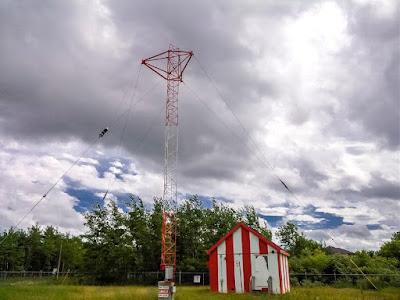 |
| ZWW - 215 courtesy: VE3GOP |
For those unfamiliar with this monthly activity, a 'CLE' is a 'Co-ordinated Listening Event', as NDB DXers around the world focus their listening time on one small slice of the NDB spectrum.
Never tried the CLE? If you've ever been wondering what can be heard 'below' the broadcast band, this weekend would be a great time to give a listen and enter your first CLE!
A nice challenge in this one is to hear 'ZWW' on 215 kHz located near Winnipeg, Manitoba. It's a 25-watter and is well-heard throughout North America. Listen for its CW identifier on 215.388 kHz (repeated every 10 seconds), with your receiver in the CW mode .
MF propagation this week has been good and signals in this frequency range should be propagating well if things stay undisturbed for the weekend.
When tuning for NDBs, put your receiver in the CW mode and listen for the NDB's CW identifier, repeated every few seconds. Listen for U.S. NDB identifiers approximately 1 kHz higher or lower than the published transmitted frequency since these beacons are modulated with a 1020 Hz tone approximately.
For example, 'AA' near Fargo, ND, transmits on 365 kHz and its upper sideband CW identifier is tuned at 366.025 kHz while its lower sideband CW ident can be tuned at 363.946 kHz. Its USB tone is actually 1025 Hz while its LSB tone is 1054 Hz.
Often, one sideband will be much stronger than the other so if you don't hear the first one, try listening on the other sideband.
Canadian NDBs normally have an USB tone only, usually very close to 400 Hz. They also have a long dash (keydown) following the CW identifier.
All NDBs heard in North America will be listed in the RNA database (updated daily) while those heard in Europe may be found in the REU database. Beacons heard outside of these regions will be found in the RWW database.
From CLE organizer Brian Keyte, G3SIA, come details via the The NDB List Group:
Hello all,
Our 241st Co-ordinated Listening Event is next weekend.
Do join in if you can. First-time CLE logs will also be very welcome.
Days: Fri. 22 Feb. - Mon. 25 Feb., Midday-Midday, your local time
Frequencies: NDBs from 190 - 239.9 kHz
PLUS: Normal NDBs with carriers on 'half-way' frequencies ‘nnn.5 kHz’
(from 190.5 - 999.5 kHz)
Both halves are for everyone to try.
Away from Europe many of the frequencies below 240 kHz are busy with
NDBs. In Europe there are very few, but some DX ones might be heard
from North America and maybe from a few other places.
The normal NDBs which have carriers on the 'half-way' frequencies
e.g. 267.5 OPW, 333.5 VOG, 370.5 LB, 390.5 ITR, 433.5 HEN (not DGPS)
are scattered across Europe but there are very few of them elsewhere.
'Hot spots' are ENG and ITA.
These half-frequencies usually give comfortable QRM-free listening
and probably some good catches as a result.
America has only one or two (e.g. 381.5 SJX in MI) but East and West
coasters might hear some DX ones.
We last used these 'rules' for CLE225 in November 2017.
Please look out for the Final Details about two days before the CLE.
73
Brian
----------------------------------------------------------------------------
From: Brian Keyte G3SIA ndbcle'at'gmail.com
Location: Surrey, SE England CLE Coordinator)
----------------------------------------------------------------------------
- determine, worldwide, which beacons are actually in service and on-the-air so the online database can be kept up-to-date
- determine, worldwide, which beacons are out-of-service or have gone silent since the last CLE covering this range
- will indicate the state of propagation conditions at the various participant locations
- will give you an indication of how well your LF/MF receiving system is working
- give participants a fun yet challenging activity to keep their listening skills honed
The NDB List Group is a great place to learn more about the 'Art of NDB DXing' or to meet other listeners in your region. There is a lot of good information available there and new members are always very welcome. As well, you can follow the results of other CLE participants from night to night as propagation is always an active topic of discussion.
You need not be an NDB List member to participate in the CLEs and all reports, no matter how small, are of much value to the organizers.
Remember - 'First-time' logs are always VERY welcome!
Reports may be sent to the NDB List Group or e-mailed to CLE co-ordinator, Brian Keyte (G3SIA), whose address appears above. If you are a member of the group, all final results will also be e-mailed and posted there.
Please ... give the CLE a try ... then let us know what NDB's can be heard from your location! Your report can then be added to the worldwide database to help keep it up-to-date.
Have fun and good hunting!
 Mr. Carlson’s Lab – A YouTube Treasure
Mr. Carlson’s Lab – A YouTube Treasure
I recently watched two superb YouTube videos. The first described exactly how to determine the 'shielded' side of a fixed capacitor and the importance of knowing this information.
As you have probably noticed, most modern fixed capacitors no longer indicate the 'grounded' end or the lead going to the internal shielding. At one time, the capacitor's polarity was commonly marked with a band on one end but this is no longer the case ... even though one side is indeed still the shielded side. Depending on exactly what part of the circuit your fixed capacitor is being used in, connecting it in the reverse direction (shield going to signal side), can introduce hum, RF pickup, instability and generally result in poorer capacitor / circuit performance ... and all it takes to determine which lead is which is an oscilloscope!
The second video I viewed shows the process used to resurrect a Yaesu FT-1000MP in truly terrible condition. In a very professional step-by-step process the video shows the logical and systematic approach at making the radio better than new.
Both videos are done by a truly gifted engineer, Paul Carlson, VE7ZWZ, and are exceptionally well done ... the quality one would expect to have to pay for rather than freely view on YouTube.
If you visit Paul's YouTube channel, you'll find a host of other radio and audio-related videos and I guarantee that you will learn something of value ... and probably hang around to watch several more. They are really well done.
 CLE240 Results
CLE240 Results
 |
| courtesy: NOAA |
Last weekend’s CLE240 saw mediocre propagation for North America and European listeners alike.
It seems that our monthly CLE schedule continues to be synced with the Sun’s monthly rotational period that has been regularly lining us up with the same massive coronal hole, elevating earth-directed solar wind speeds now for several months.
Several CLE participants in the USA commented on the lack of any propagation into BC, further fueling my long-held belief that BC seems particularly sensitive to any geomagnetic activity in the auroral zone to our north. The auroral activity always seems to dip further to the south here for some anomalous reason, as listeners just a few hundred miles to the south or southeast see far less absorption than is observed here.
With a few exceptions, the main effect of these conditions is to largely kill the normal east-west propagation path and just allow single-hop signals from the south or the SE/NW to dominate. Typically, the path to the Pacific is not affected and can often be enhanced.
As a side observation, this past weekend was also the CQWW 160m DX contest and, as one left-coaster commented, conditions were the “worst seen in 10 years”. One would expect to see much better conditions and a much quieter Sun at this point in the solar cycle!
With fingers crossed for better propagation during the next CLE, here is what was logged over the three-night listening event from my location here in BC’s Southern Gulf Islands using a Perseus SDR and an Inverted-L antenna resonated to 400 kHz:
26 05:00 385 QV Yorkton, SK, CAN
26 07:00 385 OCC Yakutat, ALS
26 09:00 385 MR Pacific Grove, CA, USA
26 09:00 385 EHM Cape Newenham, ALS
27 07:00 385 CPZ Chaparrosa Ranch, TX, USA
26 07:00 386 SYF St. Francis, KS, USA
26 09:00 386 HAU Helena, MT, USA
26 06:00 388 OK Preston, OK, USA
26 07:00 388 MM Fort Mc Murray, AB, CAN
26 07:00 388 JW Pigeon, AB, CAN
26 06:00 388 CDX Somerset, KY, USA
26 06:00 389 YWB Kelowna, BC, CAN
26 04:00 389 TW Twin Falls, ID, USA
26 07:00 389 CSB Cambridge, NE, USA
26 07:00 390 HBT Sand Point, ALS
26 11:00 390 AES Northway, ALS
26 04:00 391 TK Telkwa, BC, CAN
26 11:00 391 GXD Nacogdoches, TX, USA
26 07:00 391 EEF Sisters Island, ALS
26 06:00 391 DDP Dorado, PTR
26 09:00 392 ZFN Tulita, NT, CAN
26 05:00 392 PNA Wenz, WY, USA
26 05:00 392 ML Charlevoix, QC, CAN
26 08:00 392 FMZ Fairmont, NE, USA
26 10:00 393 UKS Kosrae, FSM
26 04:00 394 RWO Kodiak, ALS
26 07:00 394 DQ Dawson Creek, BC, CAN
26 07:00 395 YL Lynn Lake, MB, CAN
26 04:00 395 ULS Ulysses, KS, USA
26 07:00 395 5V Drumheller, AB, CAN
26 07:00 396 YPH Inukjuak, QC, CAN
26 05:00 396 CRS Corsicana, TX, USA
26 05:00 396 CMJ Ketchikan, ALS
26 07:00 397 ZSS Saskatoon, SK, CAN
27 12:00 397 SB San Bernardino, CA, USA
26 10:00 398 YOD Cold Lake, AB, CAN
26 06:00 398 3D Cumberland House, SK, CAN
26 11:00 399 ZHD Dryden, ON, CAN
26 11:00 399 SRI Pribilof, ALS
A summary of results for all participants can be found here, at the ndblist info site.
 Hunting For NDBs In CLE240
Hunting For NDBs In CLE240
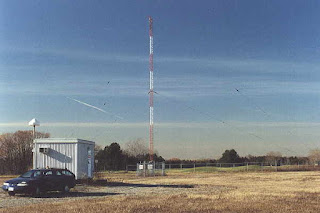 |
| OO-391kHz - Oshawa, Ontario courtesy: VE3GOP |
This coming weekend will see another monthly CLE challenge. This time the hunting grounds will be 385.0 - 399.9 kHz.
For those unfamiliar with this monthly activity, a 'CLE' is a 'Co-ordinated Listening Event', as NDB DXers around the world focus their listening time on one small slice of the NDB spectrum.
A wonderful challenge for listeners in North America is to hear little OO - 391kHz, located in Oshawa, Ontario. It puts out only 7 1/2 watts but has been logged on both coasts as well as in Europe! Listen for its USB CW identifier (with your receiver in the CW mode) on 391.396 and its LSB ID on 390.595 kHz.
MF propagation this past week has been good and signals in this frequency range should be propagating well if things stay undisturbed for the weekend. As usual however, a large coronal hole has returned to its monthly CLE position and its weekend effects are still unknown.
When tuning for NDBs, put your receiver in the CW mode and listen for the NDB's CW identifier, repeated every few seconds. Listen for U.S. NDB identifiers approximately 1 kHz higher or lower than the published transmitted frequency since these beacons are modulated with a 1020Hz tone approximately.
For example, 'AA' near Fargo, ND, transmits on 365 kHz and its upper sideband CW identifier is tuned at 366.025 kHz while its lower sideband CW ident can be tuned at 363.946 kHz. Its USB tone is actually 1025 Hz while its LSB tone is 1054 Hz.
Often, one sideband will be much stronger than the other so if you don't hear the first one, try listening on the other sideband.
Canadian NDBs normally have an USB tone only, usually very close to 400 Hz. They also have a long dash (keydown) following the CW identifier.
All NDBs heard in North America will be listed in the RNA database (updated daily) while those heard in Europe may be found in the REU database. Beacons heard outside of these regions will be found in the RWW database.
From CLE organizer Brian Keyte, G3SIA, come details via the The NDB List Group:
Hello all,
Our 240th Coordinated Listening Event is less than a week away.
We can now forget all about pyramids and relax with a straightforward
event. Whether you are a keen propagation watcher or just a
take-what-comes listener, please join in.
Days: Friday 25 January - Monday 28 January
Times: Start and end at midday, your LOCAL TIME
Range: 385.0 - 399.9 kHz
Please log all the NDBs you can identify that are listed in that range
(it includes 385 kHz but not 400 kHz) plus any UNIDs you find there.
We last used this frequency range for CLE224 in October 2017.
Please send your final log to the List (no attachments and ideally
in a plain text email) with ‘FINAL CLE240’ in its title.
Show on each line:
# The Date (e.g. '2019-01-26' etc. or just '26' )
# The Time in UTC (the day changes at 00:00 UTC).
# kHz - the nominal published frequency, if known.
# The Call Ident.
Please show those main items FIRST. Other optional details such
as Location and Distance go LATER in the same line.
As always, of course, tell us your own location and brief details
of the equipment that you were using during the Event.
We will send the usual 'Any More Logs?' email at about 18:00 UTC
on Tuesday so that you can check that your log has been found OK.
The combined results should then be completed within a day or two.
You can soon find full details about current and past CLEs from the CLE page
http://www.ndblist.info/cle.htm It includes access to CLE240 seeklists
for your part of the World, prepared from the previous loggings in Rxx.
Good listening - enjoy the CLE.
Brian and Joachim
---------------------------------------------------------------
From: Brian Keyte G3SIA ndbcle'at'gmail.com
Location: Surrey, SE England (CLE coordinator)
---------------------------------------------------------------
(If you would like to listen remotely you could use any one remote
receiver for your loggings, stating its location and owner and with their
permission if required. A remote listener may NOT also use another
receiver, local or remote, to make further loggings for the same CLE)
These listening events serve several purposes. They:
- determine, worldwide, which beacons are actually in service and on-the-air so the online database can be kept up-to-date
- determine, worldwide, which beacons are out-of-service or have gone silent since the last CLE covering this range
- will indicate the state of propagation conditions at the various participant locations
- will give you an indication of how well your LF/MF receiving system is working
- give participants a fun yet challenging activity to keep their listening skills honed
The NDB List Group is a great place to learn more about the 'Art of NDB DXing' or to meet other listeners in your region. There is a lot of good information available there and new members are always very welcome. As well, you can follow the results of other CLE participants from night to night as propagation is always an active topic of discussion.
You need not be an NDB List member to participate in the CLEs and all reports, no matter how small, are of much value to the organizers.
Remember - 'First-time' logs are always VERY welcome!
Reports may be sent to the NDB List Group or e-mailed to CLE co-ordinator, Brian Keyte (G3SIA), whose address appears above. If you are a member of the group, all final results will also be e-mailed and posted there.
Please ... give the CLE a try ... then let us know what NDB's can be heard from your location! Your report can then be added to the worldwide database to help keep it up-to-date.
Have fun and good hunting!

